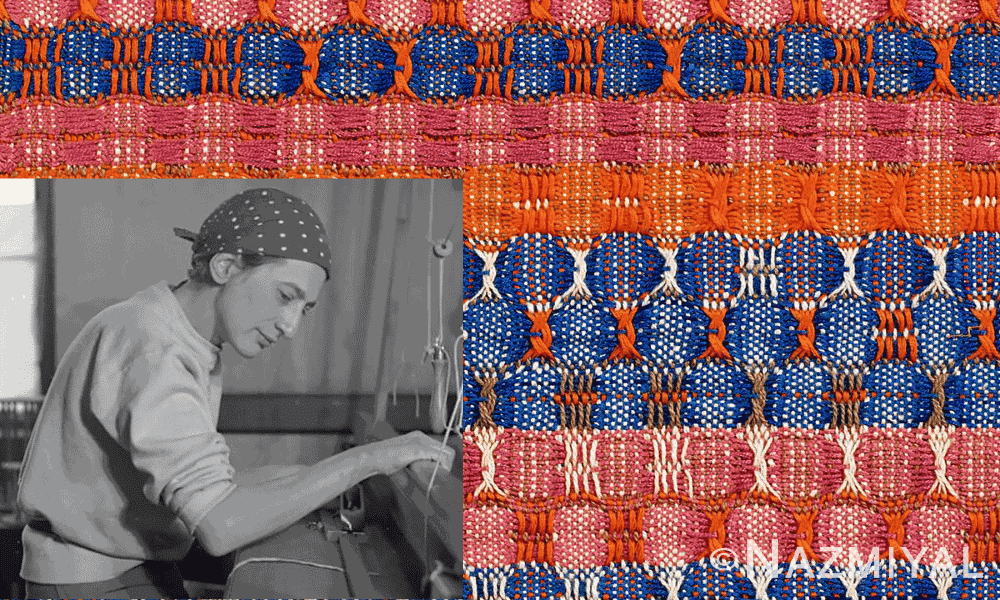Iconic Bauhaus Artist Anni Albers
It’s more than likely you’ve heard of the German art school and design movement, Bauhaus. Perhaps the most prolific artist from this movement was Anni Albers. She worked in multiple mediums but is most well known for her spectacular work in textiles. She was a pioneer for women in the arts and is still featured in many exhibitions today, nearly fifteen years after her passing.
Who was artist Anni Albers?
Anni Albers was a highly influential textile artist and designer. She was born on June 12, 1899, in Berlin, Germany, and passed away on May 9, 1994, in Connecticut, United States. Anni Albers played a significant role in the development of modern art and design, particularly in the field of textile arts.
Albers studied at the Bauhaus, a renowned German art school, from 1922 to 1933. During her time at the Bauhaus, she explored various art forms, including weaving, textile design, and printmaking. She became one of the leading innovators in the field of textile design, experimenting with materials, techniques, and patterns.

The Iconic Textile Artist – Anni Albers
Albers’s work is characterized by her innovative approach to textile art, combining abstract geometric forms with intricate patterns. She often used simple materials, such as cotton and silk, to create visually striking and sophisticated textiles. Her designs were known for their precise craftsmanship and attention to detail.
After leaving Germany due to the rise of the Nazi regime, Anni Albers emigrated to the United States with her husband, Josef Albers, who was also an influential artist and educator. In the U.S., she continued to pursue her artistic career and became an influential figure in the American art and design scene.
Anni Albers’s contributions to the field of textile art extended beyond her own artistic practice. She also played a crucial role in elevating textile art as a respected and valued art form. She taught at Black Mountain College in North Carolina and later at Yale University, where she established the weaving workshop and developed the curriculum for the textile arts program.
Throughout her life, Anni Albers exhibited her work internationally, and her textiles are part of the collections of major museums worldwide. Her artistic legacy and contributions to the field of textile art continue to inspire and influence contemporary artists and designers.
Anni Albers and the Bauhaus
Anni Albers was born in Berlin, Germany (while it was still the German Empire) in 1899, as Annelise Elsa Frieda Fleischmann. As a young woman, she loved art and painting. At the time, especially in Germany, students at art schools endured harsh living conditions and many challenges. Despite this, Anni decided to pursue her passion and attend the Kunstgewerbeschule in Hamburg for two months, and then the Bauhaus at Weimar for the remainder of her studies.

A young Anni Albers.
At the Bauhaus at the time, women were forbidden to enter certain areas of study.
You can read more about that in our post: Bauhaus Weaving Workshops: The History and its Women of 1919-1933.
During her second year at the school, she was refused admission to a glass workshop with Josef Albers, who would later become her husband. With few other options, Anni reluctantly began to study weaving. Initially, she was unhappy with her study. However, her instructor Günta Stolzl encouraged and challenged her in the craft, and she began to develop a love for weaving. Her signature weaving style of geometric designs began to develop.

Anni Albers Weaving at Bauhaus
Upon the Bauhaus’ move to Dessau in 1926, Anni’s work evolved to production of utilitarian, rather than simply beautiful, pieces. She was becoming more well known and competent in her work, and received contracts to create wall hangings, and some of her original designs were published. She worked under iconic artist Paul Klee for a time up until her graduation from the Bauhaus in 1930. She was awarded for developing the use of cellophane, at the time a new material, to create a light-reflecting, sound-absorbing wall hanging.

Material created by Anni Albers from cellophane.
Anni took over for her teacher, Günta Stolzl, in 1931 as head of the weaving workshop. Stolzl and Albers were two of very few women to ever hold a senior role at the Bauhaus. She continued this position until the Bauhaus was permanently closed by the Nazi party in August 1933. At this time, the Jewish Albers and her husband fled to the United States.

A geometric weaving by Anni Albers.
Anni Albers’ Career and Legacy
Upon her arrival in North Carolina, Albers served as an assistant art professor at Black Mountain College, alongside her husband. Her work was incredibly popular and was shown throughout the country. She was officially granted American citizenship in 1937, and her work continued to gain notoriety. Albers taught at Black Mountain College through 1949, when she and her husband moved to their final home in Connecticut and she set up a studio to work on her own art full time. It was this same year that she became the first textile artist to have a solo exhibition at the Museum of Modern Art in NYC.

Detail of “City,” woven by Anni Albers in 1949.
Throughout the remainder of her life, Albers was dedicated to her textile art and continued to create amazing artworks. She was incredibly successful, being commissioned to produce textiles for Harvard University, and had her art shown in solo exhibitions across the United States and Canada. In 1975 and then 1989, her work was shown in Germany, and after this began to spread worldwide. She was granted multiple awards and published in multiple books. Even after her passing in 1994, her work continues to be shown all across the world and her legacy lives on.

A colorful, abstract weaving by Anni Albers.
Here are some beautiful textile art pieces from the Nazmiyal Collection:
This art blog about textile artist Anni Albers was published by Nazmiyal Antique Rugs.






